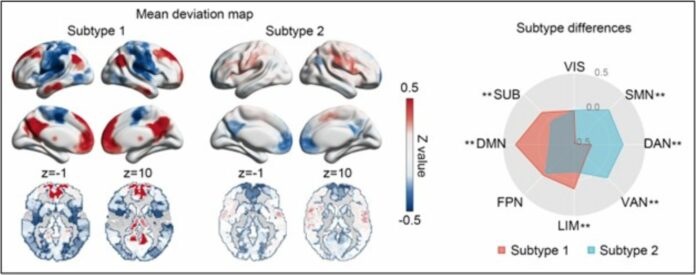A variety of disorders, including MDD, can start in youth and last throughout adulthood. The lack of quantitative study on diverse neurophysiological subtypes and functional connectome problems makes accurate diagnosis and prognosis difficult to predict.
Major depressive disorder (MDD) is a common mental illness that affects about 8% of Americans and varies significantly between individuals. Researchers have lately begun to make progress in understanding the neurophysiology underlying various forms of depression, which could hasten the development of improved treatments. Using brain imaging, a new study published in Biological Psychiatry by Elsevier found numerous subtypes of MDD.
John Krystal, MD, Editor of Biological Psychiatry, said, “We have long known that disorders like major depressive disorder are highly heterogeneous. This study in a large sample of depressed patients provides leads that can be pursued in subtyping depression based on functional magnetic resonance imaging (fMRI) tests that measure the degree of coordination across brain regions, also known as ‘functional connectivity.”
The researchers examined resting-state fMRI data from a large cohort of over 1,000 MDD patients and over 1,000 healthy controls (HC) from multiple clinical sites. They employed the normative model, which takes data from a large reference group to quantify individual variances, similar to how pediatricians use growth charts.
The researchers investigated functional connectivity among brain regions and mapped individual functional aberrations in MDD patients across the lifespan compared to this normative prediction.
According to senior author Mingrui Xia, Ph.D., of Beijing Normal University, “this approach identified two reproducible neurophysiological subtypes exhibiting distinct deviation patterns, depressive item scores, and longitudinal treatment predictability.”
One subset of patients had severe positive deviations in the default mode network, limbic, and subcortical areas and negative deviations in the sensorimotor and attention domains, indicating enhanced brain connection.
The second category of patients displayed a lesser and opposite pattern of deviation, emphasizing the neurophysiological variability of depression. The authors suggest that the changed activity may be related to patients with MDD’s proclivity to ruminate.
The research is especially interesting since it advances the field’s search for biomarkers or biological indicators of depression, which currently relies on patient-reported clinical symptoms for diagnosis, treatment, and prognosis. Biomarkers might provide a technique to enhance all facets of MDD treatment.
Dr. Xia said, “These findings shed light on the diverse neurobiological mechanisms from a connectomics perspective underlying the complex clinical heterogeneity observed in individuals with depression. The implications of this research are far-reaching, providing valuable insights into the development of imaging-based candidate biomarkers. These biomarkers can potentially guide future precise diagnostic and treatment strategies tailored to each patient’s neurophysiological subtype.”
By accepting the concept of neurophysiological subtypes, Researchers can revolutionize the mental health field by allowing physicians to personalize therapies based on each individual’s unique connectome characteristics. This method opens up new options for precision medicine and holds the prospect of improving depression therapy strategies.
The findings from the original research have a significant impact on the field or an important new lead. These findings should focus on genetic and environmental risk factors, neural circuitry and neurochemistry, and practical novel therapeutic approaches. Reviews and commentary on hot-button issues currently being researched and popular are also encouraged.
In conclusion, These findings shed light on our understanding of different neurobiological mechanisms underlying the clinical heterogeneity of MDD. They are essential for developing personalized treatments for this disorder.
The result shows that Functional connectome aberrations in MDD patients show heterogeneity, finding two neurophysiological subgroups with different depression scores and therapeutic responses.
Journal Reference:
- Xiaoyi Sun, Jinrong Sun, et al. Mapping Neurophysiological Subtypes of Major Depressive Disorder Using Normative Models of the Functional Connectome. Biological Psychiatry. DOI: 10.1016/j.biopsych.2023.05.021
